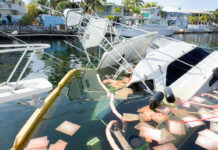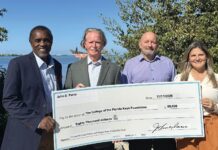There might be a new tool in the county’s toolbox against sea-level rise. The U.S. Army Corps of Engineers is finishing a three-year study to produce a plan and federal cost-sharing for adaptation and mitigation projects in the county.
At the recent Southeast Florida Regional Climate Leadership Summit in Key West, new sea-level rise projections of 10 to 17 inches near Key West by 2040 and 21 to 40 inches by 2070 set off a few alarm bells. And it’s no wonder: the entire island chain currently averages between 3 and 4 feet above sea-level.
Rhonda Haag, the county’s chief resilience officer, oversees mitigation and adaptation efforts for Monroe County. She explained the difference: adaptation is building higher, and mitigation is lessening our greenhouse gas emissions. “We will feel the effects of sea-level rise first and most, so we should do everything we can to adapt our way of life and reduce our emissions to slow sea-level rise,” she said. “We are the canary in the coal mine.”
The Army Corps’ study will examine how to make the Keys more resilient, Haag told the Weekly. At each site, it will consider strategies like shoreline resilience to ensure that U.S. 1 doesn’t wash out, natural features like mangroves to slow waves during hurricanes, and buyouts, flood-proofing or elevation of critical infrastructure. Taking into account what needs restoration or adaptation and the value of the property being protected, the Army Corps will do a cost-benefit analysis to prioritize the most important projects. “The Corps has been doing this for hundreds of years,” said Haag. “This is what they do.”
So, what’s next? The three-year study will conclude soon with a list of recommended projects, said Haag. She anticipates taking the recommendations to the February BOCC meeting for review and discussion. After getting the Army Corps’ results, the county will have a short time frame in 2020 to settle on which projects to move forward with, she said. Then comes the federal regulation process to finalize plans. Haag concluded, “So, the decisions on which projects to participate in will be in the next three months.”
As Commissioner David Rice noted at the December BOCC meeting, funding is the elephant in the room to the successful implementation of any resilience strategies. Haag confirmed that federal cost-sharing will foot 65% of the bill for projects the Army Corps recommends. Local governments will cover the remaining 35%.
Once projects are finalized, the funding will have to be appropriated by Congress and included in the federal budget. Haag cautioned that, because of this, it could take several years and up to a decade for funding to show up. “Just like the Everglades project. All these projects are good and there’s potential, but I don’t want to get too excited just yet,” she said. “If it does work, though, there will be a plan and potential cost-sharing of 65%.”
“All this will move the county forward to become more resilient, which is a good and necessary thing,” Haag said.






















